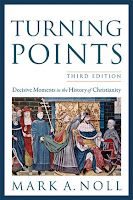Turning Points in American Church History
Elesha Coffman
Many of you are likely familiar with Mark Noll's popular church history text, Turning Points: Decisive Moments in the History of Christianity (Baker). Intended for one-semester college or seminary surveys, or for especially rigorous adult Sunday school classes, the book gives an overview of church history through chapters on just 14 pivotal events including the Council of Nicaea, the East-West schism, the French Revolution, and the Edinburgh Missionary Conference. According to the acknowledgements, the book originated in an attempt to condense the notes for a two-week course, to be taught to theological students in Romania, onto one 4 x 6 index card. Impressive.
Recently I've been pondering what a short list of turning points in American church history might include. It's a daunting mental exercise, for a number of reasons:
1. "Event" is a mushy category. Some of the events on Noll's list (e.g. the Diet of Worms) were short and discrete, while others (the French Revolution and Vatican II) spanned a few years. Still others (Benedict's Rule) were documents, the composition of which can be dated more precisely than their impact.
Under this generous definition, the Battle of Antietam could be a turning point in American church history, but so could the Civil War as a whole or Lincoln's Second Inaugural Address. And each of the three potentially illustrates a different larger trend, including the turn toward total war (Harry Stout's focus in Upon the Altar of the Nation), a loss of faith in both Providence and the cultural authority of the Bible (Noll's argument in The Civil War as a Theological Crisis), or the development of American civil religion (highlighted by Robert Bellah and others). Too many possibilities!
2. Some trends in American church history aren't easily pegged to events, however defined. Here, I'm thinking especially of women's history. Sure, a few dates come to mind: the trial of Anne Hutchinson, 1637; Seneca Falls, 1848; The Woman's Bible, 1895; Aimee Semple McPherson's dedication of the Angelus Temple, 1923. But I find it hard to think of these events as turning points, because they didn't really change much.
Women persistently struggled to speak for themselves, religiously, and faced consequences when they did. Each potential "turning point" merely began another circle. On the other hand, several slow-moving developments, such as falling birthrates, rising levels of education, and changing economic roles, profoundly altered women's religious lives--but these developments are nearly impossible to date.
3. American church history is both too big and too small to lend itself to a "top 14" list. It's the classic survey course problem. With an unfathomably large subject, like Western Civ. or church history from Acts to the present, you know you can barely scratch the surface in one semester, so you pick your spots and go with it. You can't possibly be blamed for not touching on everything. OK, you actually will be blamed, by students whose favorite subjects are slighted or by the yahoos who write state curriculum standards, but deep down you'll know that kind of criticism is rubbish.
American church history, though, initially seems manageable enough to extract its essence through a dozen-plus perfectly selected focal points. But the list can't just feature a cast of white, male Protestants. And it can't be too New England-centric. And if African Americans or Roman Catholics or women or (fill in the blank) only get one turning point, that will look like tokenism. And then there's the whole question of world religions and world events that aren't in American church history but exert a strong influence on it. Very quickly, the list of possible turning points balloons out of control.
Nonetheless, as an Americanist who teaches church history, I can't ignore this puzzle. My last round of teaching evaluations reaffirms the fact that students really, really hate it when they can't figure out how the things they've learned fit together. "Why this and not that?" they ask. "Why this before that? Why this, or that, at all?" I know it would help if I could identify, at least for myself, the short list of things students ought to remember, and what these things illustrate, and why it matters. It would probably be even better if I could squeeze it all onto a 4 x 6 card. What would you write on yours?


Comments
Whether the list is 14 or 24 or less, no definitive list will materialize, but that is what makes for good discussion and debate (and learning!).
Recently, I was asked by my local church to offer a 7 week evening class on Church History. I took the opportunity to expand it into a series of short articles. I called it Seven Summits in Church History.
Jason G. Duesing
Southwestern Baptist Theological Seminary
However, McPherson latched onto the New Testament verse "Jesus Christ is the same yesterday, today and forever," meaning in part Jesus had the power to heal in modern times as in the ancient days. Her healing ministry gave actual credence to that.
Biographer Epstein writes "The healings present a monstrous obstacle to scientific historiography. If events transpired as newspapers, letters, and testimonials say they did, then Aimee Semple McPherson's healing ministry was miraculous. ...The documentation is overwhelming: very sick people came to Sister Aimee by the tens of thousands, blind, deaf, paralyzed. Many were healed some temporarily, some forever. She would point to heaven, to Christ the Great Healer and take no credit for the results." Daniel Mark Epstein (p111 Sister Aimee: The Life of Aimee Semple McPherson).
For participants both the healed and the witnesses observing, it was longer difficult at all to believe in the actual historical miracles of Jesus, his Virgin Birth and even Resurrection. Modernist Christianity, just could not effectively argue against those types of results. Matthew Avery Sutton in his book (Aimee Semple McPherson and the Resurrection of Christian America. 2007) conveys her contribution stalled the modernists and effectively resulted in the the revitalization of Christan America.